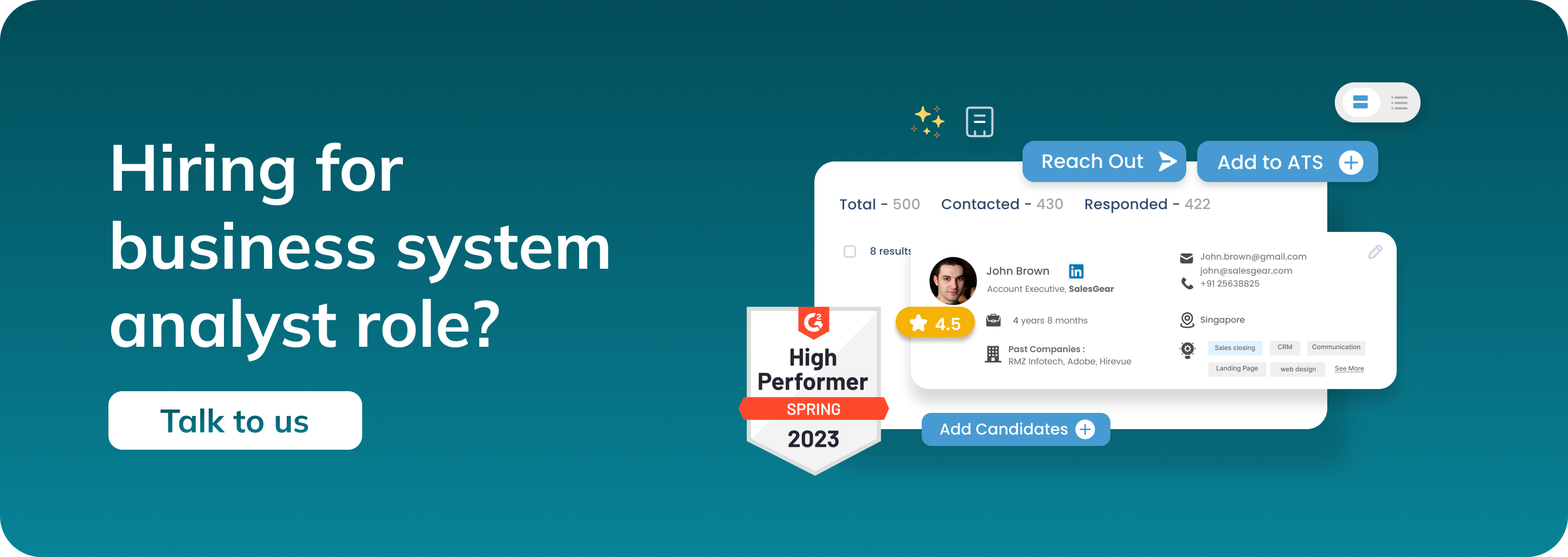Business Systems Analyst Interview Questions
Published on June 1st, 2023
Introduction
Welcome to the Business Systems Analyst Interview question bank. This question bank is designed to assist you in evaluating candidates for the role of Business Systems Analyst. The Business Systems Analyst plays a crucial role in bridging the gap between business needs and technical solutions within an organization. They are responsible for analyzing business processes, identifying system requirements, and facilitating the successful implementation of technology solutions.
This question bank covers a wide range of topics, including requirements gathering, process analysis, system design, testing, and documentation. The questions are designed to assess a candidate's knowledge, skills, and experience in these areas, enabling you to identify top candidates who can effectively analyze and optimize business systems to drive operational efficiency and meet organizational goals
Business Systems Analyst Interview Questions
Question: How do you gather and analyze business requirements for system development or enhancement projects?
Answer: I gather business requirements by conducting stakeholder interviews, analyzing existing documentation, and facilitating workshops. I then analyze these requirements to identify key objectives, constraints, and success criteria for the system development or enhancement project.
Question: Can you describe your experience with process mapping and modeling techniques?
Answer: I have extensive experience with process mapping and modeling techniques such as BPMN (Business Process Model and Notation) and UML (Unified Modeling Language). I use these techniques to visually represent business processes, identify inefficiencies, and design solutions that streamline operations and improve productivity.
Question: How do you identify and document functional and non-functional requirements for a system?
Answer: I identify functional requirements by defining the specific actions and behaviors the system must perform to meet user needs. I document these requirements using techniques such as use cases, user stories, and requirements traceability matrices. For non-functional requirements, I identify constraints related to performance, security, scalability, and usability, documenting them alongside functional requirements to ensure comprehensive system specifications.
Question: How do you ensure that business requirements are translated accurately into technical specifications?
Answer: I ensure accurate translation of business requirements into technical specifications by maintaining clear communication channels between business stakeholders and technical teams. I facilitate collaborative sessions to review and validate requirements, address any ambiguities or discrepancies, and ensure alignment between business objectives and technical solutions. Additionally, I leverage tools such as prototyping and mock-ups to visualize system functionality and validate requirements before implementation.
Question: Can you explain your approach to conducting system testing and validation?
Answer: My approach to system testing and validation involves defining test scenarios and cases based on system requirements, conducting thorough testing at each stage of development, and validating system functionality against acceptance criteria. I collaborate closely with developers and QA teams to identify and resolve issues promptly, ensuring that the system meets quality standards and user expectations before deployment.
Question: How do you collaborate with developers and testers to ensure successful system implementation?
Answer: I collaborate with developers and testers by providing clear and detailed requirements documentation, facilitating regular communication and feedback sessions, and participating in sprint planning and review meetings. I also conduct knowledge transfer sessions to ensure that developers understand the business context and user needs, and work closely with testers to validate system functionality and address any defects or issues identified during testing.
Question: Can you provide an example of a project where you had to manage conflicting system requirements?
Answer: In a recent project, we encountered conflicting requirements related to system performance and user interface design. To address this, I facilitated discussions between stakeholders to prioritize requirements based on business impact and technical feasibility. We conducted trade-off analyses and compromise discussions to reach consensus on a solution that balanced competing priorities and met project objectives effectively.
Question: How do you prioritize system enhancements or change requests based on business impact?
Answer: I prioritize system enhancements or change requests based on their alignment with strategic objectives, potential impact on business operations, and urgency of implementation. I collaborate with business stakeholders to assess the value and priority of each request, considering factors such as ROI, customer impact, regulatory requirements, and resource availability.
Question: How do you handle scope changes and requirements modifications during system development?
Answer: I handle scope changes and requirements modifications by following established change management processes, assessing the impact of proposed changes on project objectives, timelines, and resources, and obtaining approval from relevant stakeholders before proceeding. I communicate changes effectively to all project team members and adjust project plans and documentation accordingly to ensure alignment with updated requirements.
Question: What tools or methodologies do you use for requirements management and traceability?
Answer: I use a variety of tools and methodologies for requirements management and traceability, including requirement management tools such as JIRA and TFS, version control systems such as Git, and traceability matrices to track requirements throughout the project lifecycle. I also adhere to industry-standard methodologies such as Agile, Scrum, and Waterfall to ensure effective requirements management and traceability practices.
Question: How do you collaborate with stakeholders to elicit and document business requirements for system integration projects?
Answer: I collaborate with stakeholders by conducting interviews, workshops, and focus groups to elicit business requirements, capturing their needs, preferences, and pain points. I document these requirements using techniques such as use cases, user stories, and process diagrams, ensuring that they are clear, concise, and actionable for technical teams.
Question: Can you describe your experience with conducting feasibility studies and cost-benefit analysis for system enhancements or implementations?
Answer: I have extensive experience conducting feasibility studies and cost-benefit analysis for system enhancements or implementations. I assess the technical feasibility, economic viability, and organizational impact of proposed projects, considering factors such as resource requirements, potential risks, and anticipated benefits. I collaborate with stakeholders to identify and evaluate alternative solutions, and recommend courses of action based on a comprehensive analysis of costs, benefits, and risks.
Question: How do you ensure that system requirements are traceable and align with the overall business objectives?
Answer: I ensure that system requirements are traceable and align with the overall business objectives by establishing clear traceability links between business requirements, functional specifications, and technical design documents. I use requirements management tools and traceability matrices to track changes, dependencies, and relationships between requirements throughout the project lifecycle, ensuring that
Conclusion
The role of a Business Systems Analyst is essential in ensuring the alignment of technology solutions with business objectives. By utilizing this question bank, you can assess candidates based on their ability to understand business processes, elicit and document system requirements, and effectively communicate with stakeholders and development teams. The questions cover various aspects of the Business Systems Analyst role, enabling you to evaluate a candidate's technical expertise, analytical thinking, problem-solving skills, and attention to detail. Remember to tailor the questions based on your organization's specific needs and the level of the role you are hiring for. By selecting the right Business Systems Analyst, you can enhance your organization's systems and processes, drive efficiency, and facilitate successful technology implementations
Role-based Business Analyst Interview Questions:
- Top 75+ Business Analyst Interview Questions
- IT Business Analyst Interview Questions
- Entry Level Business Analyst Interview Questions
- Senior Business Analyst Interview Questions
- Data Business Analyst interview questions
- Agile Business Analyst Interview Questions
- Domain Business Analyst Interview Questions
- Business Systems Analyst Interview Questions
- Data Business Analyst interview questions
- Top 25+ Business Process Analyst Interview Questions
Miscellaneous Business Analyst Questions:
- Business Analyst Agile Interview Questions
- Technical Interview Questions for Business Analyst
- SQL Interview Questions for Business Analyst
- Business Analyst Behavioral Interview Questions
Hire the best without stress
Ask us how
Never Miss The Updates
We cover all recruitment, talent analytics, L&D, DEI, pre-employment, candidate screening, and hiring tools. Join our force & subscribe now!
Stay On Top Of Everything In HR


